Click
here to be transferred to our list of Microscopes and Illuminators
Return
to Main page
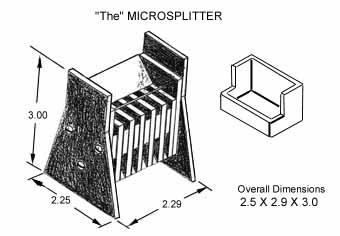
The
hard to find item - and at such a reasonable price, better buy two today.
These come on the market and then are not available for years. Next
time we would like one of you to go through the development costs, manufacturing
and marketing hassles but here it is in all its glory designed especially
for the micropaleontologist but useful to other specialist as well e.g.
isotope geologist, biologists sedimentologists and other small parts workers.
Most
Foraminifera are 1 mm in diameter or less so that the chutes were designed
for a safety
factor
of "3" .125 inches - 3.175 mm. Larger material will need to be looked
at separately. There are six
chutes on each side, three pans accompany the splitter for the purchase
price. Additional pans are
available.
Back
To Top
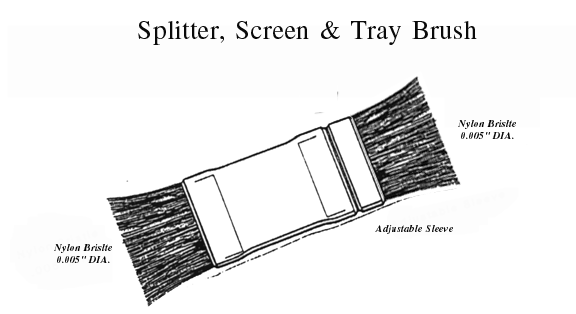
A
brush designed especially for the micropaleontologist but also for the
sedimentologist. The
brass
end is designed for cleaning 3" dry screens. The adjustable sleeve
controls the stiffness of the brass
bristles so that all loose sand grains and forams stuck in the screen can
be easily brushed out. The nylon bristle
is useful in cleaning the picking tray, and the splitter receiving pans.
Back
To Top
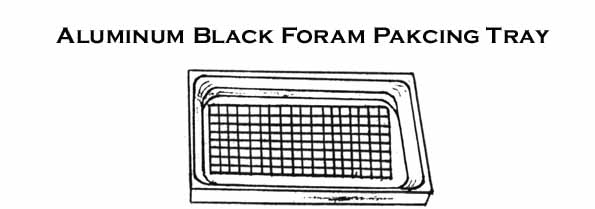
This
is a convenient sized picking tray for the working area provided by most
biological binocular microscopes. Trays
are designed to increase work speed with small objects from cursory exam
to detailed quantitative studies. These
trays are constructed of aluminum and have been anodized black.
There are 2 size grid trays available. A l cm x 1 cm grid (5 rows,
9 columns) and a 0.5cm x 0.5cm grid
(10 rows, 18 columns) are imprinted on the tray used for quantitative counting.
Overall
Dimensions 4.38" x 2.75" x 0.5"
Back
To Top
THE
SLIDE PUSHER AND BLOCK WITH GLASS PICKING TRAY
Two
additional aids for the professional micropaleontologist and hobbyist are
the slide pusher (for' opening and
closing slide holders and wood block with a glass picking tray. In
industry it has been found by many
paleontologists that the prepared sample can be examined more readily by
laying the sample in a mound or in
rows on the glass picking tray and pushing the grains and fossils across
the glass slide with a disecting pick.
This works well when the number of forams or micromount materialis low
compared to the number of sand grains.
By
brushing the sample material across the glass slide many otherwise unrecognized
specimens can be observed by rolling
and turning. The sand grains can be cast aside. When a specimen is deemedworth
saving it can often be touched with the end of the dissecting needle.
The static electricity on theneedle is generally enough to remove the specimen
to the 1 x 3 cardboard slide. If the specimen does not
adhere to the needle, the needle can be passed through the hair on the
head (assuming the paleontologist is
not bald). This increases the static electricity on the needle to
the point where the specimen can conveniently
be removed to the cardboard slide for later identification. If this
still does not transfer the specimen
from the sample to the slide, a dampened "OO" camels hair brush willgenerally
do the trick. The platform for the cardboard 1 x 3 slide is so elevated
that racking the microscope up and
down to focus is not necessary.
The
slide pusher is used to open and close the completed slide. The completed
slide is composed of a 1 x 3 glass
slide, an aluminum slide holder and the cardboard fossil slide sandwiched
between the aluminum and glass.
By gently pushing down on the aluminum slide clip on both bottom and topedges,
the cardboard slide will be held firmly in place. The fossils can
be held in the slide loose orglued down as preferred.
To
open the slide for re-examination the fiat end of the slide pusher is inserted
between the glass and aluminum and
pushed sideways far enough so that the paleontologist can grasp the cardboard
with a thumb and index finger.
With loose unmounted material care must be taken to insure that the slide
is not jarred and specimens lost.
Back
To Top
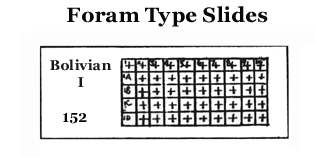
Some
thoughts by a slightly used, balding, overstuffed paleontologist. Taxonomy
has been the
nemesis
of paleontologist for 2.5 centuries. Linneus certainly never saw
the advent of computers or the need
to keep straight more than a few hundred thousand species of living and
dead animals. The 10th edition
of Systema Naturae, 1758, a voluminous volume yielded only
a small percentage of the known species
of today. Even Linneus probably realized that the system would need
to be upgraded within a few decades.
Now, a quarter of a millennia later, we as professionals need to review
where we are in trying to handle the
multitude of data we have generated. We need to correct if we can,
the mental pain of organizing plant
and animal life as well as over 70,000 (+,-) species of the order Foraminifera.
Is
this unthinkable? Why would anyone imagine that a better system might
be possible? My experience as
an economic paleontologist suggests to me that adjustments to the old system
would be of value. The opportunity
to take advantage of the modern computer, with its available software systems,
is essential.
Back To Top
CONVENIENT
NEW SLIDES FOR TYPES: This group of slides is for the professional economic
and
academic micropaleontologist. Naturally, all good academic paleontologists
want to report their results in academic
terms, in the latest correct nomenclature. This system is designed
to meet this requirement. It
aids the paleontologist in creating a very stable nomenclature with a maximum
of taxonomic flexibility. Without
the computer this has been difficult. Sometimes I think that the
game of name changing is to confuse
the uninitiated. This has discouraged a number of excellent mindsfrom
considering the field as a scientific endeavor.
With
10 species per slide, room is available for more specimens than with the
Curtin sixty square slide with twelve
squares across the top.
The
utility of this system is that it is an open ended, accession number system
with each slide
containing
room for 10 species and four varieties each from four stratigraphic horizons
or geographic areas. For instance,
Elphidium
fax s.l. would be put in the Elphidium slide in square 3; Elphidium
fax ss. in square 3A; Elphidium
concinnum in 3B; Elphidium fax barbarense in 3C; Elphidium fax pingue 3D,
Elphidium excubitor 3E, ad infinitum.
The Bolivina H slide would carry species numbered from 11-20
and varieties of these species. Bolivina
Ill species would be 21-30, with variations and subspecies, in
the A, B, C ... rows. Note: Generic &
specific name changes can be logged into the computer and cross
indexed. But, the location of the species remains
unchanged either correctly or incorrectly, but you know where
you put it in your types. Each species square is divided into four
quadrants as illustrated below:
Square
3C of the Elphidium I Slide would carry
Elphidium fax pingue
Q1-
Early Miocene ecimens
Q2-
Mid Miocene specimens
Q3-
Late Miocene specimens
Q4-
Early Pliocene specimens
Back To Top
If
more than four stratigraphic or geographic variants are needed to properly
define all the speciesan Elphidiurn fax pingue a second Elphidium
slide with a prime after the Elpkidium I [Elpkidium I' ] slideadds room
for four more specimens of Elphidium fax pingue.
Type
slides can be ordered from Green Geological, with the generic names in
Kroy letters on the slide or left blank
as preferred. The additional cost of Kroy work is charged out at
current drafters scale $25/hour.
Also, all genera that were valid and acceptable at the time Loeblich and
Tappan published their treatise "C"
on the Foraminifera for the GSA have been sequentially numbered.
As in the case of Bolivina it
is the 152nd valid genus. The valid genera are listed in the index
of the GSA Treaties Pt C in bold type.
The advantage of the slides now becomes apparent since when putting species
into the computer the generic code
i.e. BOL or 152+ species no., e.g. 152-31 requires only six strokes ratherthan
19 for Bolivina californica. The computer reads this out on
a species list or distribution chart asBolivina californica.
If it becomes apparent that Bolivina californica
is truly a Brizalina california a quick
computer change will update your output name but you need never lose the
fact that in yourtypes it is found in slide 152-31. Hence, the integrity
of your earlier work is intact. You can with these
slides be taxonomically up to date as acceptable new taxonomy is included
in your work. This can be a valuable
time saver since it is necessary to push a maximum of only 8 keys on the
computer under the worst condition
to record a species e.g., Valvulineria is genus #1379 and a variety
of Valvulineria california such
as Valvulineria california obesa would be encoded as 1379104C. Thus
27 letters vs. eight characters
reduces the time necessary to record a species. Numbers produce fewererrors
when recording data.
This system keeps all species, varieties, subspecies, age, and geographic
variants easily
accessible
and the taxonomy up to date. Perhaps there won't be a need for "The
New Taxonomy" after all. It may have
just arrived on your desk today. Type sheets are illustrated on the
next page. Record environmental, stratigraphic,
taxonomic, and nomenclatual information. These can be usedconveniently
with the new type slides.
GREEN'S
SLIDES
We now offer several types of slides as below:
(1)
18 ply 1-Hole - thickness 0.07511', 0.07508-0.07513**, 0.0005'**
(2)
18 ply 4-Hole - as above
(3)
28 ply 1-Hole - thickness 0.13200*
(4)
28 ply 4-Hole - as above
(5)
38 ply l-Hole - thickness 0.18900*
(6)
38 ply 4-Hole - as above
(7)
48 olv I Hole thickness 0.24600*
(8)
Type slides as described in our flyer
(9)
60 square assemblage slide [under development, two thicknesses planned
Note:
a.
The minimum order is 100 slides per order for all the items.
b.
Price of item (1) - (7) and (9) $100/100slides
c.
Price of item (8)$200/100slides
a.
Aluminum slide holders and glass cover slides are priced separately.
e.
* Average thickness in inches, ** Range in thickness in inches
*** Variation in thickness in inches
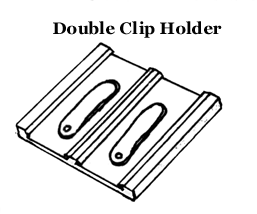
The
double clip is used to transfer specimens for comparison for placing specimens
in types
slides.
It is designed to hold only 18 ply slides. The spring under each slide
holds the examination surface at the
same elevation to reduce racking up and down.
Back To Top
Return
to Main Page




